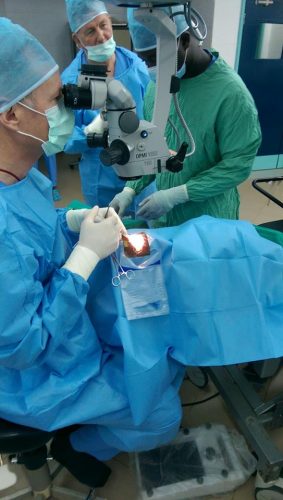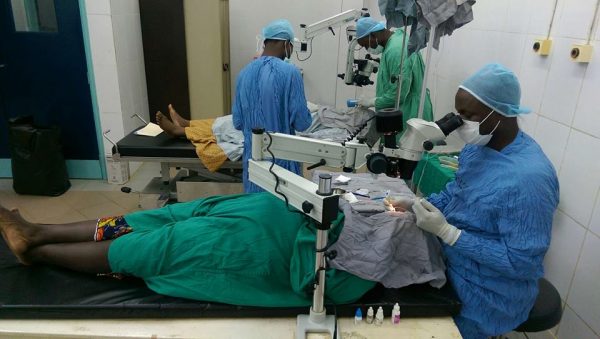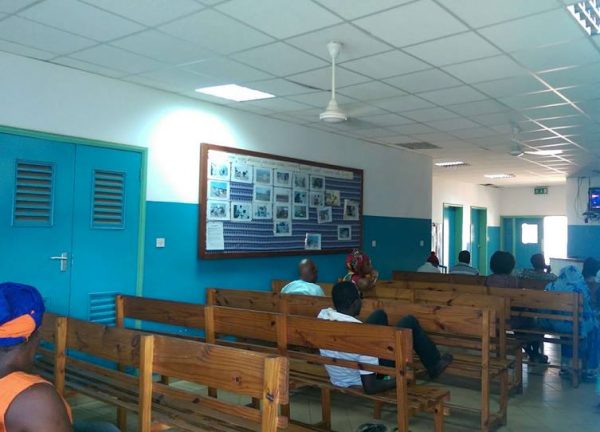Thursday is theatre day in SZRECC, and four of the children we’d seen on Monday had been listed for Dave to remove their cataracts. Despite us seeing over 20 children with cataracts, 9 of them were bilateral, making them the higher priority. Unfortunately due to the anaesthetist being ill yesterday, Dave was unable to operate, and losing precious theatre time in which some more cataracts could have been removed.
The day began once again with teaching, something I really think that Singleton and other UK hospitals could learn from, by having a short session each morning. Though the schedules have been cleared for the visiting team to present talks, usually it’s an opportunity for staff to present cases, audits, and for the students to receive general teaching. John presented a talk on surgical treatment of lower lid entropion (when the lid folds inwards, which can lead to severe irritation from eyelashes scratching on the surface of the eye), and then I presented an introduction on using logMAR visual acuity tests (a far more accurate way of testing visual acuity than on the historic Snellen chart). The hospital is looking to transition over to logMAR in the near future, so hopefully the training will come in handy for that occasion.
 As there are few patients booked on Thursdays, and no children, I spent the remainder of the day in theatre. I watched Dave operate on the paediatric cataract cases, and some of the adult cataract surgery happening in the next theatre. I was entrusted with John’s expensive camera, and like last year, set about taking interesting pictures without getting in anyone’s way too much. I was also asked by Dave to adjust the microscope at one point which made me feel highly important. The children had the cloudy lens in their eye removed and replaced with an artificial implant made of plastic, which is calibrated in such a way that as the eye grows it becomes the correct size for the lens’s power. Glasses are still required after the operation, to fine-tune any refractive error that is left outstanding, and also to provide near-task focussing through a bifocal or varifocal. The children with bilateral cataracts will most likely have their second cataract removed at a later date, but at least for now they will have a renewed opportunity to develop the vision in one eye.
As there are few patients booked on Thursdays, and no children, I spent the remainder of the day in theatre. I watched Dave operate on the paediatric cataract cases, and some of the adult cataract surgery happening in the next theatre. I was entrusted with John’s expensive camera, and like last year, set about taking interesting pictures without getting in anyone’s way too much. I was also asked by Dave to adjust the microscope at one point which made me feel highly important. The children had the cloudy lens in their eye removed and replaced with an artificial implant made of plastic, which is calibrated in such a way that as the eye grows it becomes the correct size for the lens’s power. Glasses are still required after the operation, to fine-tune any refractive error that is left outstanding, and also to provide near-task focussing through a bifocal or varifocal. The children with bilateral cataracts will most likely have their second cataract removed at a later date, but at least for now they will have a renewed opportunity to develop the vision in one eye.
 Adult cataracts in the Gambia are removed by cataract surgeons, eye trained nurses who have trained in the surgical technique. They use a revolutionary technique called Manual Small Incision cataract surgery (MSICS), which is very cheap, very fast while being highly effective, and generally requiring no stitches and no post-operative assessment. Watching Amadou perform this surgery was amazing as the procedure was completed in little more than 25 minutes, and afterwards, underneath their protective eyepatch, the patient now had an eye with mostly restored vision. As cataracts are so common in Sub-Saharan Africa and the developing world in general, this technique is now widespread.
Adult cataracts in the Gambia are removed by cataract surgeons, eye trained nurses who have trained in the surgical technique. They use a revolutionary technique called Manual Small Incision cataract surgery (MSICS), which is very cheap, very fast while being highly effective, and generally requiring no stitches and no post-operative assessment. Watching Amadou perform this surgery was amazing as the procedure was completed in little more than 25 minutes, and afterwards, underneath their protective eyepatch, the patient now had an eye with mostly restored vision. As cataracts are so common in Sub-Saharan Africa and the developing world in general, this technique is now widespread.
I found watching both types of procedure highly rewarding, and really put into perspective the magnitude of the problem that the Gambia faces. A cataract surgeon will on average operate on around 8 patients per session, and despite having several different surgeons available at one time, the amount of patients requiring treatment means that they’re operating flat out, all day, every day. Even so, for every patient successfully treated, there are dozens more living with visual impairment.


